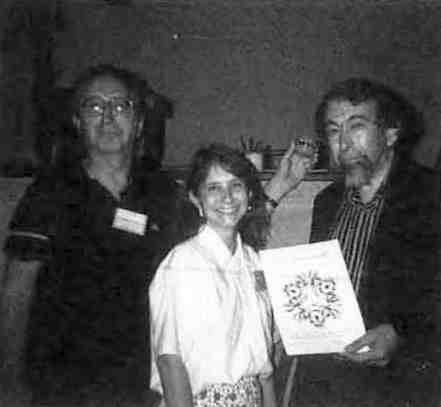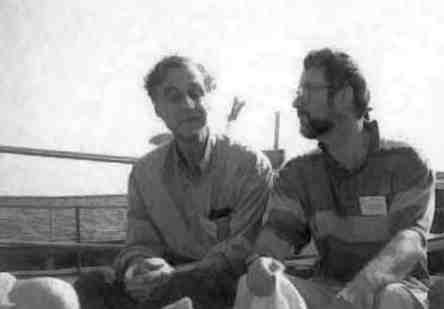


Meeting report
Erice 1994 - A Student's Perspective
 Lodovico Riva di Sanseverino and Tom Blundell present the Dynamic Young Participant award to Amy Swain at the 1994 Erice School for Molecular Biology. (Photo courtesy of V. Cody.)
Lodovico Riva di Sanseverino and Tom Blundell present the Dynamic Young Participant award to Amy Swain at the 1994 Erice School for Molecular Biology. (Photo courtesy of V. Cody.)
Every crystallographer should go to a school in Erice at least once! Erice, Sicily is a beautiful medieval village set on top of a mountain overlooking the island and the Mediterranean Sea. The scenery is breathtaking and the cobblestone streets and stone buildings can make you believe that you have gone back in time to the 15th century. That is, until you enter the lecture hall filled with 200 scientists, several of whom are the authors of the books, manuals and articles that have literally taught you crystallography. It is truly a privilege to be in an environment where you can learn from the masters through lectures, as well as having many chances to socialize and discuss science in an informal setting (i.e., on a tour bus, over dinner, on the beach ... )!
Although the School for Molecular Biology held in Erice had more the character of a conference than a school, it was an excellent forum for learning how the latest methods are actually being used in practice. Through instructive lectures, we learned about cryo-crystallography techniques (A. Yonath), synchrotron source data collection (K. Moffat), detector technology (Y. Amemiya and D. Thiel), MAD phasing (J. Smith), maximum likelihood (G. Bricogne), electrostatics (B. Honig), and complementary phasing using X-ray data and electron microscopy (D. Stuart and R. Huber). In addition, we were taught, through the descriptions of particularly difficult structure determinations, how to practically use every piece of information available from a variety of sources. This was particularly exemplified by the beginning of E. Baker's lecture, entitled "The use of anomalous scattering with multiple models and data sets to identify and refine a weak molecular replacement solution: ... !"
 Robert Huber and Keith Moffat afloat at the 1994 Erice School for Molecular Biology. (Photo courtesy of V. Cody.)
Robert Huber and Keith Moffat afloat at the 1994 Erice School for Molecular Biology. (Photo courtesy of V. Cody.)
The three poster sessions were a good place to learn about many new structures, program packages, and methods. The size of the sessions, with 35-40 posters, provided an opportunity for in-depth discussion of almost every presentation. Personally, I have never experienced such interest and discussion over a poster, and I believe it is the intimate nature of the Erice conference and relaxed atmosphere that promotes such interchanges. These poster sessions, as well as two ad hoc lecture sessions on "Hot Topics" and "Hot Structures", gave the students a chance to share the results of their research.
Accolades are due to T. Blundell and W. Hendrickson for their direction and organization. And the warm and personal attention paid to each and every participant by L. Riva di Sanseverino, P. Spadon and their excellent staff was unforgettable.
Amy Swain

